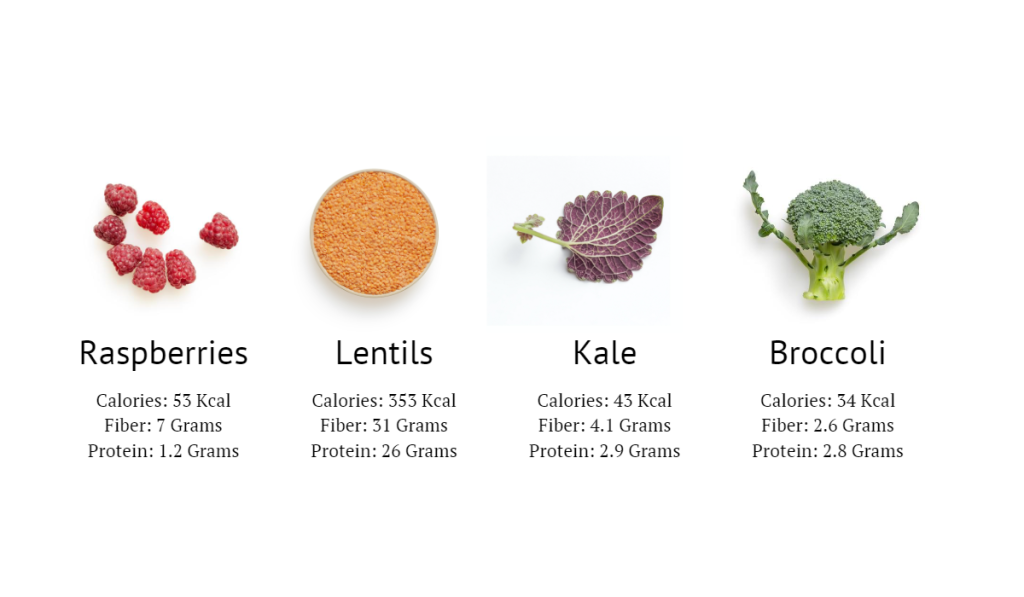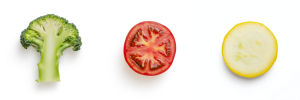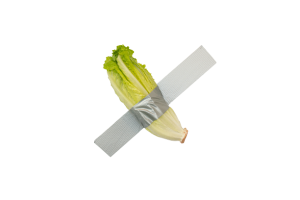Fiber is one of the most omitted nutrients in the modern diet, and it plays a significant role in the contemporary obesity pandemic. The cause of this problem is refining food. As we more and more pursue pure nutrients in the food industry, we get more high-calorie products with less helpful nutrients such as fiber. This problem affected me hard when I tried to lose weight, that’s why I invented a special high fiber foods chart that we now use in CalorieAid which improved my health dramatically, and it can be easily incorporated into your diet too. In this article, we’re exploring what fiber is, its types, benefits, your daily needs, and my CalorieAid Fiber chart. So keep reading if you want to be healthier in the long run.
Table of Contents
A Personal Experience With Fiber
As I was experiencing different foods and trying to lose weight at the same time, I accidentally messed up my personal fiber intake for a month or so. My bowel habits gradually shifted to abnormal then constipation and bloating. As I realized what I have done, I added fiber to my diet and my bowel movement improved. Also, I was always hungry as well. When I add fiber to my diet my satisfaction after every meal improves greatly. On the other hand, when a patient asks me for a good laxative to buy due to a medical condition like anal hemorrhoids or fissures I almost always don’t recommend one. Instead, I tell them to increase their consumption of dietary fiber, and I teach them how to do it the same way I am going to tell you now. Controlling your fiber intake is the key to controlling your toilet habits.
What is fiber & its types?
Fiber is essentially a type of carbohydrate that your gut can’t digest. When you digest carbs, You break them down into simple sugars and absorb them via your bloodstream. Unlike other carbs, Your gastrointestinal system cannot digest fiber. So it passes through your system without absorption. There are two types of fiber that are present in your diet:
- Soluble fiber. This type can dissolve in water and can help regulate both your glucose and cholesterol blood levels which lead to controlling your hunger level.
- Insoluble fiber. This type can’t dissolve in water and is responsible for your digestive tract health. It regulates bowel movement and prevents constipation.
You don’t need to concern yourself too much with fiber types. You only need to have around 14 grams of fiber for every 1000 kcal of your diet. For example, if your diet is 2000 kcals per day, your fiber intake will be 28 grams.
How does this high fiber food chart work
The most unique principle of this high fiber foods chart is the calorie-to-fiber ratio. First of all, you have to remember, calorie is like money. When you eat something, you pay the price in calories. So the more fibers and fewer calories a food or an ingredient have, the more I scored it higher on this list. Let me give several examples to help you understand: compare 100 grams of rice that have 370 kcals and 3.5 grams of fiber with lentils that have 353 kcals and 31 grams of fiber. Obviously, the lentils are the better choice here for 2 important reasons: firstly, you don’t want to eat rice all day because it’s boring and it affects your compliance with your diet. Secondly, you need to spend the rest of your “money” to get other macronutrients. That’s why this concept is fundamental to this chart.
One last thing to consider here is the amount of protein in a food. Because we want protein in our food, we gladly pay for it with our calories. Calories from proteins are considered good calories, and for the sake of refining this list, I excluded the protein calories from the total calories of food. If we go back to our previous example, Lentils have 26 grams of protein while rice has only 8, and this favors lentils even greater than before. Our final equation for deciding which foods are better for getting fiber looks like this:
(Total calories-Protein Calories)/Fiber (g)
The ratio that will result from this can be used as a scale to determine which foods are more efficient to provide our diet with fiber. The lowest the ratio, the better. Making these formulas to decide which foods and food combinations are superior for our diets is what we ultimately do in CalorieAid.

The relationship to serving size
Based on what I discussed, you might conclude that the smaller the serving size you can get fiber from the better. And you would be wrong and right. Because the high fiber food chart is not dependent on just calories, but rather on caloric density. The caloric density of a food is the number of calories in a given food weight. I have gone in-depth on the concept of caloric density and high-volume low-calorie foods in this article. Foods with high fiber and low caloric density are optimal for this list. In other words, foods that are high in fiber, high in volume, and low in calories. Picking foods with these attributes increases the serving size, and due to stretch receptors in our stomach, this leads to satiation. With that being said, you can’t find many foods with all of these qualities, so you will have to make exceptions sometimes.
The High Fiber Food Chart
Without any further ado, here’s the high fiber foods chart. I included the most basic ingredients like whole grain flour instead of whole grain bread or pasta so the list can suit everybody. You can grow this list further by adding more items that you love, and customize it to your liking. Or maybe you just want to use bran flour and get a very high fiber percentage in your food effortlessly. Now that you have a grasp of the fundamentals of building this list, you can easily modify it.
| Calories | Fiber | Protein | Ratio | |
|---|---|---|---|---|
| Rasperries | 53 | 7 | 1.2 | 6.885714286 |
| Kale | 43 | 4.1 | 2.92 | 9.487804878 |
| Brussel Sprouts | 43 | 3.8 | 3.4 | 10.31578947 |
| Lentils | 353 | 31 | 26 | 10.38709677 |
| Cauliflower | 25 | 2 | 1.9 | 11.5 |
| Broccoli | 34 | 2.6 | 2.8 | 12.07692308 |
| Split Peas | 341 | 26 | 25 | 12.11538462 |
| Fava Beans | 341 | 25 | 26 | 12.64 |
| Navy Beans | 337 | 24 | 22 | 13.04166667 |
| Chia Seeds | 486 | 34 | 17 | 13.29411765 |
| Carrots | 41 | 2.8 | 0.9 | 13.64285714 |
| Turnip | 28 | 1.8 | 0.9 | 14.55555556 |
| Strawberries | 32 | 2 | 0.7 | 15 |
| Green Peas | 81 | 5 | 5 | 15.2 |
| Pears | 57 | 3.1 | 0.4 | 17.38709677 |
| Orange | 47 | 2.4 | 0.9 | 18.58333333 |
| Barley, hulled | 354 | 17 | 12 | 19.82352941 |
| Chickpeas | 364 | 17 | 19 | 20.41176471 |
| Apples | 52 | 2.4 | 0.3 | 20.66666667 |
| Black Beans | 341 | 15.5 | 21.6 | 21 |
| Avocado | 160 | 6.7 | 2 | 22.88059701 |
| Popcorn, Air poped | 387 | 15 | 13 | 24.8 |
| Rye Flour | 349 | 12 | 11 | 28.08333333 |
| Whole Wheat | 340 | 10.7 | 13.2 | 30.77570093 |
| Sweet Corn | 86 | 2.7 | 3.2 | 30.85185185 |
| Potatoes | 77 | 2.2 | 2 | 31.36363636 |
| Banana | 89 | 2.6 | 1.1 | 33.23076923 |
| Oats | 307 | 8.1 | 10.7 | 36.90123457 |
| Almonds | 579 | 13 | 21 | 43.53846154 |
| Sunflower Seeds | 582 | 11 | 19 | 51.90909091 |
| Quinoa | 385 | 6.95 | 11.9 | 54.39568345 |
| Pistachio Nuts | 562 | 10 | 20 | 55.2 |
| Brown Rice | 370 | 3.5 | 8 | 104.7142857 |
*Nutritional Info for 100 grams, raw.
How to incorporate this chart into your daily diet
You have probably noticed a theme. Most of the foods that have the same ratios in the chart belong to the same dietary group (legumes, whole grains,…etc.) We can incorporate fiber in two major strategies here:
- Have a main carb that is one of the whole grains which is considered according to our high fiber foods chart a food with a medium fiber level.
- Have a side dish or a snack that contains one of the foods that rank high on the list.
I made these guidelines in order to not get fiber above your daily needs because excess fiber causes diarrhea. As I mentioned before, you need 14 grams of fiber for every 1000 kcals. going above that limit will only disturb your bowel movement.
Kitchen ideas for including foods from this chart
Here are some things you can do in the kitchen to have more fiber in your diet:
- Top your breakfast oats with a fruit that contains a lot of fiber, like pears or raspberries. Also, consider adding nuts like almonds and pistachios for an added flavor, a layer of texture, and a little bit more fiber.
- Have a legume soup, like lentil soup or split pea soup.
- Place high-fiber veggies as sidedish strategically, like cauliflower au gratin and kale salad next to a delicious steak or a roasted chicken.
- Consider fruits for desserts or fruit salads. Have them in small portions after each and every meal.
- Consider adding high-fiber veggies to one-pot dishes like big soups (minestrone) or one-pot roast. Crank up the flavor by adding herbs and spices.
- Legumes purees are amazing. And I am talking about hummus and refried beans. They are enjoyable and nutritious.
I am totally against boring healthy cooking. I won’t eat chicken breasts, broccoli, and brown rice every day. It doesn’t have to be like that. I cooked many delicious meals when I was on a caloric deficit to lose weight and you can do that too. Let me know in the comments if you have other creative ways of incorporating fiber into your meals.
Conclusion
We are almost done here. I hope this high fiber foods chart helps you in getting fiber regularly into your daily diet for a healthier lifestyle. Fiber is an important part of our diet and it is important for our gut health and post-meal satisfaction. We need to spend calories wisely when it comes to our macronutrients, and fiber is an important one to consider. Always try to get 2 in 1 and aim for good protein content as well. Now I want to hear from you: which food should we add to this list to make it bigger? Let me know in the comments and share this article with a friend that needs more fiber in their diet.


